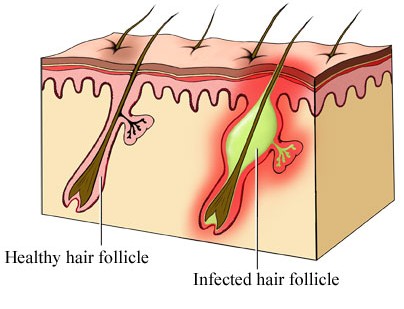Folliculitis is the medical term used to refer to inflammation of hair follicles. Infected hair follicles are very common and they appear as pinpoint red bumps, and in some cases there is presences of a dot of pus at the tip. This skin disorder affects people of all ages from infants to the elderly. The tiny smooth red bumps are commonly seen on the face, legs, bum, back, chest and scalp around hair follicles. Healthy people also get folliculitis, and it is easy to treat. Mostly, it heals on its own but there might be need for maintenance therapy.
Causes of Folliculitis

An infected hair follicle can be caused by bacteria, yeast or other types of fungus. When a hair follicle is damaged, you are likely to get folliculitis. Clothes that rub against the skin or shaving can irritate the hair follicles leading to folliculitis. Irritation or blockage could also occur as a result of makeup, machine oils or sweat. Once a follicle is injured, an infection is likely to occur.
You are at a greater risk of getting folliculitis if:
- You have a condition that lowers your immunity, like HIV;
- You have an infected surgical wound, scrape or cut. The fungi or bacteria can spread to the follicles nearby;
- You work or use substances that can cause blockage or irritation to the follicles, for example creosote, tar, motor oil, cocoa butter and make up;
- You use a swimming pool, hot tub or whirlpool that is not well treated with chlorine;
- You wear tight clothes.
Folliculitis is classified as deep or superficial depending on how much the follicle is involved.
Symptoms of Folliculitis
Signs and symptoms of an infected hair follicle include:
- A big swollen mass or bump
- Pain or tenderness
- Burning or itchy skin
- Inflamed and red skin
- Blisters filled with pus that break open and crust
- Clusters of white tipped pimples or small red bumps that form around the hair follicle
When to Call a Doctor
- The area with the bumps becomes warm, swollen, and red or becomes more painful
- Fever over 38°C (101°F)
- The infection keeps coming back or spreads
Treatment of Folliculitis
1. Minor Cases
Most cases of infected hair follicle are minor and treatment is not required. Normally, the infection will clear on its own in 7 to 10 days. However, it is helpful if you use a moisturizer that has antibacterial properties. This will soothe and improve the condition of your skin. It can also decrease the chance of aggravating the condition as well as hasten the healing process.
For minor cases, home care can help. You can:
- Wash the affected area. Gently clean the affected area using antibacterial soap twice a day. Use a clean towel and washcloth. Clean them with warm soapwater after use and do not share with other people.
- Apply calming lotions. You can calm the itchy feeling using hydrocortisone cream or an oatmeal lotion.
- Use a warm compress or moist washcloth. By doing this several times in a day youwill relieve the skin’s discomfort. You can use salty water (1 tsp. of salt in two cups of water) as well.
2. Localized Infected Hair Follicle
An antibiotic cream can come in handy for localized folliculitis. You can apply fusidic antibiotic cream 3 to 4 times a day on the affected parts.
3. Mores Serious Cases
Antibiotic tablets can be useful if the folliculitis is widespread or serious.
4. Chronic or Long-term Folliculitis
This is a case that occurs when the infection keeps coming back after disappearing with treatment. The duration it takes to strike back might keep reducing with each new attack. Eventually, you get chronic folliculitis. If this happens, the doctor can take a sample of the infected skin for further testing. This will enable him/her to know the exact bacteria responsible for the infection. If the results show S. aureus, it is advisable to take more swabs mostly from the nose, in order to determine if you are a carrier of the bacterium.
If you are a staphylococci carrier and you have chronic or recurrent folliculitis, then that is most likely the reason. To treat this, the bacterium has to be destroyed in order to prevent folliculitis from recurring. Three types of treatment are engaged simultaneously. First is a dose of antibiotic tablets, second is antibiotic nasal cream. Since the staphylococci can be present on other parts of the body, it is recommended to use an antiseptic shower gel or skin wash, preferably with chlorhexidine. Use a hot wash to launder your towel, beddings and clothing. Lastly, you should go for repeat swabs to ensure that you are free of the bacteria. 3 swabs in 3 weeks will give confirmation on whether the bacterium is gone completely.
Prevention of Folliculitis
- Do not share personal items like towels and nail cutters.
- Avoid sources of contamination or make sure they are toughly cleaned like contact sports equipment and hot tubs.
- Personal hygiene is very important, especially in situations that could lead to transmission from other persons like locker rooms and showers, and in hot and humid places.
